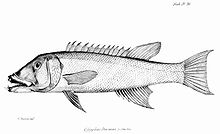Semicossyphus darwini
| Semicossyphus darwini | |
|---|---|

| |
| Scientific classification | |
| Domain: | Eukaryota |
| Kingdom: | Animalia |
| Phylum: | Chordata |
| Class: | Actinopterygii |
| Order: | Labriformes |
| Family: | Labridae |
| Genus: | Semicossyphus |
| Species: | S. darwini
|
| Binomial name | |
| Semicossyphus darwini | |
| Synonyms | |
| |
Semicossyphus darwini is a species of ray-finned fish native to the tropical eastern Pacific Ocean. Common names include the Chilean sheepshead wrasse,[citation needed] the goldspot sheepshead or the Galapagos sheepshead wrasse.[1]
Description
This is a large wrasse, with a maximum length of 70 cm (28 in). The dorsal fin has twelve spines and ten soft rays while the anal fin has three spines and twelve soft rays.[3]
Distribution and habitat
S. darwini is native to the tropical eastern Pacific Ocean. Its range includes the Galápagos Islands and on the coast of South America, extends from Ecuador southward through Peru to northern Chile. It is normally found among seaweed, including deep-water kelp forests, and its depth range is from 3 to 100 m (10 to 330 ft).[1]
Ecology
The strong sharp teeth provide evidence of its diet as a
Status
S. darwini is caught for food throughout its range and is fished commercially in the Galápagos Islands. It is a large, and probably a slow-growing, fish which makes it vulnerable to over exploitation. There was a decline of 80% in the Galapagos populations during the 1997–1998
References
- ^ . Retrieved 20 November 2021.
- ^ Bailly, Nicolas (2018). "Semicossyphus darwini (Jenyns, 1842)". WoRMS. World Register of Marine Species. Retrieved 1 July 2018.
- ^ a b Froese, Rainer; Pauly, Daniel (eds.) (2019). "Semicossyphus darwini" in FishBase. August 2019 version.
- ^ ISBN 978-0-520-27886-8.
External links
- Photos of Semicossyphus darwini on Sealife Collection

